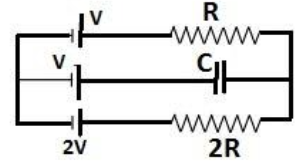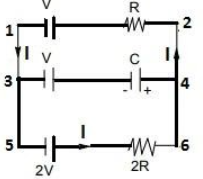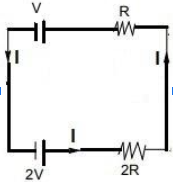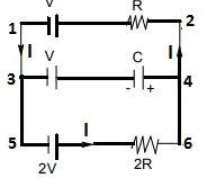
The circuit shown in the figure is in steady state. Find the potential difference across the capacitor.

(A) $V$
(B) $\dfrac{V}{2}$
(C) $\dfrac{V}{3}$
(D) $\dfrac{{2V}}{3}$
Answer
218.4k+ views
Hint Neglect the branch that has a capacitor attached with. Then, find the current in the remaining circuit. Then, select any one loop including the branch with capacitor and apply Kirchhoff’s Voltage Law.
Step by Step Solution

When the circuit is in steady state, then, the branch having capacitor can be neglected or omitted. Then, the equivalent circuit becomes –

Then, find the equivalent current in the circuit by using Kirchhoff's Voltage Law for finding the current which states that, “the voltage across a loop is equal to the sum of every voltage drop is equal to zero in the same loop”.
Therefore, in the above circuit, applying Kirchhoff’s Law, we get –
$
- V + 2V - IR - 2IR = 0 \\
2V - V = I\left( {R + 2R} \right) \\
$
By transposition, finding the value of current –
$
I = \dfrac{{2V - V}}{{R + 2R}} \\
I = \dfrac{V}{{3R}} \\
$
Now, considering the below circuit –

In the loop 43564, let the voltage across the capacitor be ${V_c}$. So, applying the Kirchhoff’s Law, we get –
$
- {V_c} - V + 2V - 2IR = 0 \\
{V_c} = - V + 2V - 2IR \cdots \left( 1 \right) \\
$
We have already got the value of current, $I = \dfrac{V}{{3R}}$. So, putting this value in the equation, we get –
$
{V_c} = - V + 2V - 2 \times \dfrac{V}{{3R}}2R \\
{V_c} = V - \dfrac{{2V}}{3} \\
{V_c} = \dfrac{V}{3} \\
$
Hence, the value of voltage across the capacitor is $\dfrac{V}{3}$.
Therefore, the correct option is (C).
Note The Kirchhoff’s Laws helps us to calculate the electrical resistance of a complex network or impedance of Alternating Current (AC). It also helps us in calculating the current flow in different loops or streams of the circuit. There are following two Kirchhoff’s Laws
Kirchhoff’s Current Law It states that the total current inside the junction is equal to the sum of current outside the junction.
If current inside the junction is ${I_i}$ and current outside the junction is ${I_o}$. Then, according to the Kirchhoff’s Current Law –
$
{I_i} = {I_o} \\
\Rightarrow {I_i} - {I_o} = 0 \\
$
And the other Kirchhoff’s Law is Kirchhoff’s Voltage Law.
Step by Step Solution

When the circuit is in steady state, then, the branch having capacitor can be neglected or omitted. Then, the equivalent circuit becomes –

Then, find the equivalent current in the circuit by using Kirchhoff's Voltage Law for finding the current which states that, “the voltage across a loop is equal to the sum of every voltage drop is equal to zero in the same loop”.
Therefore, in the above circuit, applying Kirchhoff’s Law, we get –
$
- V + 2V - IR - 2IR = 0 \\
2V - V = I\left( {R + 2R} \right) \\
$
By transposition, finding the value of current –
$
I = \dfrac{{2V - V}}{{R + 2R}} \\
I = \dfrac{V}{{3R}} \\
$
Now, considering the below circuit –

In the loop 43564, let the voltage across the capacitor be ${V_c}$. So, applying the Kirchhoff’s Law, we get –
$
- {V_c} - V + 2V - 2IR = 0 \\
{V_c} = - V + 2V - 2IR \cdots \left( 1 \right) \\
$
We have already got the value of current, $I = \dfrac{V}{{3R}}$. So, putting this value in the equation, we get –
$
{V_c} = - V + 2V - 2 \times \dfrac{V}{{3R}}2R \\
{V_c} = V - \dfrac{{2V}}{3} \\
{V_c} = \dfrac{V}{3} \\
$
Hence, the value of voltage across the capacitor is $\dfrac{V}{3}$.
Therefore, the correct option is (C).
Note The Kirchhoff’s Laws helps us to calculate the electrical resistance of a complex network or impedance of Alternating Current (AC). It also helps us in calculating the current flow in different loops or streams of the circuit. There are following two Kirchhoff’s Laws
Kirchhoff’s Current Law It states that the total current inside the junction is equal to the sum of current outside the junction.
If current inside the junction is ${I_i}$ and current outside the junction is ${I_o}$. Then, according to the Kirchhoff’s Current Law –
$
{I_i} = {I_o} \\
\Rightarrow {I_i} - {I_o} = 0 \\
$
And the other Kirchhoff’s Law is Kirchhoff’s Voltage Law.
Recently Updated Pages
A square frame of side 10 cm and a long straight wire class 12 physics JEE_Main

The work done in slowly moving an electron of charge class 12 physics JEE_Main

Two identical charged spheres suspended from a common class 12 physics JEE_Main

According to Bohrs theory the timeaveraged magnetic class 12 physics JEE_Main

ill in the blanks Pure tungsten has A Low resistivity class 12 physics JEE_Main

The value of the resistor RS needed in the DC voltage class 12 physics JEE_Main

Trending doubts
JEE Main 2026: Application Form Open, Exam Dates, Syllabus, Eligibility & Question Papers

Derivation of Equation of Trajectory Explained for Students

Hybridisation in Chemistry – Concept, Types & Applications

Understanding the Angle of Deviation in a Prism

Understanding Collisions: Types and Examples for Students

Understanding Atomic Structure for Beginners

Other Pages
JEE Advanced Marks vs Ranks 2025: Understanding Category-wise Qualifying Marks and Previous Year Cut-offs

How to Convert a Galvanometer into an Ammeter or Voltmeter

Understanding Centrifugal Force in Physics

JEE Main Marking Scheme 2026- Paper-Wise Marks Distribution and Negative Marking Details

Degree of Dissociation: Meaning, Formula, Calculation & Uses

Understanding Electromagnetic Waves and Their Importance




